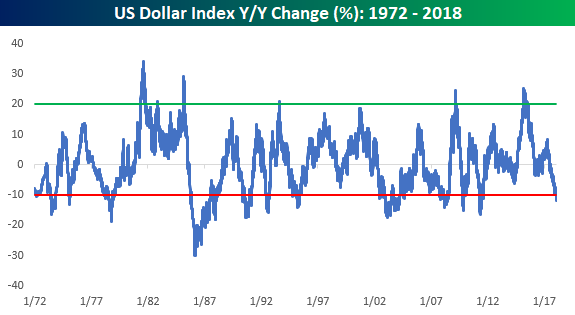The falling dollar has become a hot topic of conversation this week as back and forth comments from Treasury Secretary Mnuchin regarding the Administration’s view on the greenback caused some confusion in markets and among investors. While the dollar has been weak to kick off 2017, it is only the continuation of the same trend we saw in 2017 after the US Dollar Index peaked in late 2016 right after the election of President Trump.
The chart below shows the y/y change in the US Dollar Index going back to 1972 where readings below the red line indicate y/y declines of more than 10% and readings above the green line indicate periods when the US Dollar Index was up over 20% y/y. With a decline of 11.64% since this point last year, the Dollar Index is seeing its worst y/y decline since June 2011 when financial markets were growing skittish about the impasse over the budget and debt ceiling in Congress. Looking back over time, though, a double-digit percentage decline in the US Dollar Index is not too uncommon. In the last 46 years, there have been 12 distinct periods where the US Dollar Index was down by as much or even more than the decline over the last year.
What is a lot less common the recent decline in the US Dollar Index, however, is the magnitude of the gain that preceded it. Back in mid-2015, the US Dollar Index was up over 20% on y/y basis for its strongest one-year gain since the lows of the Financial Crisis, and before that, there were only four other periods where the dollar rallied by a similar magnitude. Like just about every other strong rally in the US Dollar Index, the one in 2015 was also met with a period of weakness/mean reversion.

When it comes to the dollar, it’s moves have a big impact on stock price performance. Using our International Revenues Database (available to Premium and Institutional members), we have created two baskets of S&P 500 stocks. The first one – Domestics – is comprised of companies that generate 90% or more of their revenues inside the United States. The other basket – Internationals – is made up S&P 500 stocks that derive more than half of their revenue outside the United States. The chart below summarizes the performance of both baskets since the start of 2017, just when the US Dollar Index was peaking. Looking at the results, the performance figures aren’t even close. While the Domestics have seen a gain of just over 15% during this span, the International basket has more than doubled that with a gain of 33.5%!














Leave A Comment